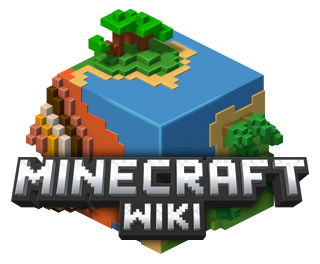cerca de 23% da tradução está concluída
A Geração se refere a jogadores e mobs sendo criados e colocados no mundo do jogo. Jogadores irão reaparecer em seu ponto de surgimento, ou na Cama que ele dormiu pela última vez antes da morte. Mobs vão desaparecer após a morte.
Surgimento do jogador
Surgimento no Mundo
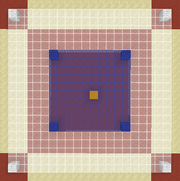
Área de surgimento do mundo. Branco representa a expansão do modo jogador único, azul representa Multijogador, e amarelo representa o ponto real de surgimento do mundo.
Novos jogadores vão inicialmente surgir dentro de uma pequena área em torno do ponto de surgimento do mundo quando o servidor não está no modo aventura. Essa área é de 20×20 blocos no modo único jogador, enquanto a área em si é compensada na direção noroeste do ponto de surgimento do mundo. No modo multijogador,a área depende da configuração spawn-protection no arquivo de configuração server.properties do servidor. A partir da versão 1.9, essa área é controlada pela "gamerule" spawnRadius no modo único jogador e multijogador. Após a morte, o jogador irá reaparecer nesta área a menos que ele tenha mudado seu ponto de surgimento individual.
Ao ressurgir, o jogador será colocado no bloco mais alto das coordenadas X e Z correspondentes que eles podem surgir, mesmo se isso definir o jogador acima da altura máxima de construção (256). Esta área não considerará a existência de um bloco para "spawnar" o jogador, o que pode resultar em jogadores surgindo no void/vazio.
O ponto de surgimento do mundo também determina o centro dos blocos de surgimento permanentemente carregados.
O ponto de surgimento do mundo pode ser alterado com o comando /setworldspawn.
Modo Aventura
Quando nas configurações do servidor está seleto como modo padrão o modo Aventura (usando o arquivo server.properties), a mecânica normal de surgimento é ignorada e os jogadores surgem diretamente na coordenada de surgimento. Isso inclui os valores X, Y e Z, mesmo se não houver bloco algum lá ou se tiverem blocos, o que pode fazer o jogador morrer após surgir.
Se a coordenada Y não é uma área de surgimento válida, o servidor procura até encontrar uma, muitos jogadores podem surgir em Y=256. Se houver espaço para aparecer, mas é no meio do ar, o jogador vai aparecer no meio do ar, mesmo caindo no vazio se houver um buraco.
Surgimento Individual
O ponto individual de surgimento de um jogador pode ser mudado dormindo em uma Cama ou usando o comando /spawnpoint. Se a área individual de surgimento de um jogador estiver obstruída após sua morte, ele irá reaparecer na área de surgimento do mundo.
Geração Natural
Muitos mobs geram na criação inicial de um Chunk. Esses surgimentos só acontecerão uma vez por Chunk. Eles não são afetados pela regra do jogo doMobSpawning.
Animais

A cow that generated with the map inside a tree's leaves and could not escape, a common sight in forested hill areas.
Aproximadamente um em dez chunks gerados vai conter mobs, geralmente em grupos de até quatro da mesma espécie. Eles vão sempre surgir no bloco mais alto disponível em uma coluna, basicamente aquele que pode ver o céu. Para um animal surgir, o bloco precisa ser opaco e os dois blocos acima deste devem ser transparentes (Ar). O bloco não precisa ser um bloco de grama nem precisa ser iluminado como acontece com o surgimento dos mobs.
Animais não surgem no deserto (exceto morto vivo e Coelhos). E somente Coguvacas irão surgir no Bioma Ilha dos cogumelos
Randomness for animal spawning is derived from the world seed, which means that worlds with the same seed will generate chunks with the same animals in the same places.
Other mobs
- Villagers generate as part of the village generation.
- A single witch will spawn within a witch hut upon generation. If your view distance is above 8 this will put her more than 128 blocks away and she will instantly despawn.
- Three elder guardians generate as part of a single ocean monument.
- A single ender dragon is created in the End when the dimension is created.
Spawn cycle
Mobs are broadly divided into four categories: hostile, friendly, water (i.e. squid) and ambient (i.e. bat). Hostile mobs have a spawning cycle once every game tick (1/20th of a second). Friendly and water mobs have only one spawning cycle every 400 ticks (20 seconds). Because of this, where conditions permit spawning, hostile mobs spawn frequently, but passive mobs (ie: animals) spawn very rarely. Most animals spawn within chunks when they are generated.
Mobs spawn naturally within a square group of chunks centered on the player, 15×15 chunks (240×240 blocks). When there are multiple players, mobs can spawn within the given distance of any of them. However, hostile mobs (and some others) that move farther than 128 blocks from the nearest player will soon despawn, so the mob spawning area is more-or-less limited to spheres with a radius of 128 blocks, centered at each player. In multiplayer, mob caps are shared by all players, no matter where they are.
Mob cap
Mob caps are directly proportional to the total number of chunks eligible for spawning. To calculate the cap, the spawning area is expanded by one chunk in every direction (so the default gives 17×17 chunks), then the total number of chunks is plugged into the following formula:
cap = constant * chunks / 289
Each mob category has a separate cap and a different constant in the formula:
Hostile = 70 Passive = 10 Ambient (Bats) = 15 Water (Squids) = 5
In single player mode, there are always 289 chunks in range so the caps above are used. In multiplayer, chunks that are in range of multiple players are only counted once. So the more spread out the players are, the more chunks will be covered and the higher the caps will be.
The amount of mobs is checked once at the beginning of each spawning cycle against the cap. If the number of living mobs in a category is over its cap, the entire spawning cycle for that category is skipped. The area checked for mobs is the same as the area used for calculating the mob cap, which is the spawning area expanded by one chunk in every direction.
Pack spawning
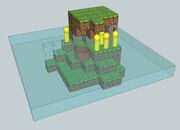
Example of a mob pack spawning. The 41×1×41 spawning area is shaded blue (not to scale). The yellow figures represent the actual positions that mobs could spawn in after checking the environment. Note that the mobs can spawn inside torch and ladder blocks. But they can't spawn on top of glass because it's not opaque. The red cube is the center of the pack.
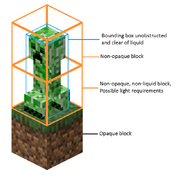
Requirements for the spawning location of individual mobs
For each spawning cycle, one attempt is made to spawn a pack of mobs in each eligible chunk. A random location in the chunk is chosen to be the center point of the pack. For the pack to spawn at all, the center block must non-opaque, or must not fill its entire cube, or must be powered.
If the pack location is suitable, 12 attempts are made to spawn up to a pack, which is 8 wolves, 1 ghast, 3 rabbits, or 4 of any other mob. The pack is spawned within a 41×1×41 (that's a 41×41 square that is one block high) area centered at the initial block. Mobs will spawn with the lowest part of their body inside this area. For each spawn attempt, a block location within the pack area is chosen at random. Though the pack area extends 21 blocks out from the center, the random location is heavily skewed toward the center of the pack. Approximately 85% of spawns will be within 5 blocks of the pack center, and 99% within 10 blocks of the center.
All mobs within a pack are the same species. The species for the entire pack is chosen randomly from those eligible to spawn at the location of the first spawn attempt in the pack:
- In the Overworld, this depends on the location:
- Forest, taiga, mega taiga, and cold taiga biomes and their variants can also spawn wolves.
- Plains and savanna biomes can also spawn horses, though savannas spawn horses only 1/5 of the time as plains.
- Jungle biomes can also spawn ocelots, and increase the chance to spawn chickens.
- Desert, beach, stone beach, river, ocean, mesa, and snowy biomes (except cold taiga) cannot spawn animals; only hostile mobs and squid.
- Mushroom island biomes can spawn only mooshrooms.
- Witch huts can only spawn witches.
- Ocean monuments can only spawn guardians.
- The rest of the locations can spawn sheep, pigs, chickens, cows, rabbits, spiders, zombies, skeletons, creepers, endermen, slimes, witches, and squid.
- Slimes will only spawn if they are in any eligible chunk under layer 40, or in a swamp biome at a low light level.
- In the Nether, the locations are less varied,
- Skeletons, wither skeletons, and blazes can spawn within Nether fortresses.
- Ghasts can spawn everywhere that does not belong to a nether fortress.
- Zombie pigmen and magma cubes can spawn anywhere in the Nether.
- In the End, only endermen will spawn.
Spawn conditions
Each individual spawn attempt succeeds only if all of the following conditions are met:
- There must be no players and no player spawn points within a 24 block distance (spherical) of the spawning block
- If it's a squid or a guardian, then...
- the spawning block must contain liquid (water or lava)
- If it's a squid, then...
- the spawning block must be between level 46 and 62, inclusive
- the spawning mob must not be obstructed by other mobs
- If it's a guardian, then...
- the difficulty must not be peaceful
- 95% chance of failure if the spawning block has sky exposure (details)
- If it's not a squid or a guardian, then...
- the block directly below it must have a solid top surface (opaque, upside down slabs / stairs and others)
- the block directly below it may not be bedrock or barrier
- the spawning block itself must be non-opaque and non-liquid
- the block directly above it must be non-opaque
- the spawning mob hitbox must not be obstructed by solid blocks, other mobs or liquids
- If it's a bat, then...
- the spawning block must be at level 62 or below
- If the real-time day is between October 20 and November 3, then the light level must be 7 or darker. Otherwise the light level must be 4 or darker.
- If it's an animal (other than a mooshroom or ocelot), then...
- the light level of the spawning block must be 9 or brighter
- the block directly below the spawning block must be grass
- the light level of the spawning block must be 9 or brighter
- If it's a mooshroom, then...
- the light level of the spawning block must be 9 or brighter
- the block directly below the spawning block must be mycelium
- the light level of the spawning block must be 9 or brighter
- If it's an ocelot, then...
- If it's a hostile mob (except as noted below), then...
- the difficulty must not be peaceful
- the light level of the spawning block must be 7 or darker (with exception during thunderstorms), and more light increases the chance that the spawn will fail
- sunlight falling on the spawning block further increases the chance that the spawn will fail, by up to 50%
- If it's a slime, then...
- the light checks in the general hostile mob check don't apply
- one of the following must be true:
- option 1:
- the spawning block must be in a chunk eligible to spawn slimes (see the slime page for details)
- the spawning block must be below level 40
- 90% chance of failure
- option 2:
- the spawning block must be in a swamp biome
- the spawning block be on level 51 through 69 inclusive
- chance of failure based on the phase of the moon
- the light level of the spawning block must be 7 or darker, and more light increases the chance that the spawn will fail
- 50% chance of failure
- option 1:
- If it's a ghast, then...
- the light checks in the general hostile mob check don't apply
- there is a 95% chance the spawn will fail, thus ghasts only spawn 1/20th as often as other mobs
- If it's a magma cube or zombie pigman, then...
- the light checks in the general hostile mob check don't apply
- If it's a blaze, then...
- the light checks in the general hostile mob check don't apply
- the light level must be 11 or darker
- If it's a skeleton in the Nether, then...
- there is an 80% chance of spawning a wither skeleton instead
If all of these conditions are met then the mob is spawned. The pack is complete when 4 mobs have spawned (or 8 wolves, or 1 ghast, or 3 rabbits), or 12 attempts have been made, whichever comes first. The exception(s) to these rules is the ender dragon or the wither.
Notes
- Due to the general block checks, all mobs besides squid must spawn on top of an opaque block with at least two blocks of headroom, even ghasts, etc. However, short mobs can spawn in a one block high space if the block above is transparent, like a glass block or piston.
- Individual mobs and packs can spawn inside signs, pressure plates, and other blocks that have no collision boxes. However, in 1.9 (upcoming), they cannot spawn on any type of rails.
- Similarly, buildings surrounded by air will spawn more mobs inside than underground rooms because packs that spawn outside of the building can spawn mobs inside it.
- The mob caps tend to be reached in seconds. Because of this, mobs can be funneled into a spawning room by preventing them from spawning outside of it.
- The caps also mean that the faster mobs are killed, the faster they will spawn.
- Because the caps are only checked at the beginning of a spawn cycle, they can be dramatically exceeded when a large number of mobs spawn in a single cycle. This happens often with squid, which have a fairly low cap (5 in single player) but can spawn in the hundreds in a single cycle, in an area with lots of water.
- If the player's view distance or the server view distance in multiplayer is at 9 or below, mob spawning is severely reduced (or they despawn too quickly), and may result in the player encountering no mobs at all. Set the view distance to 10 or higher to ensure mobs spawn correctly.
Other types of spawning
- Cows, chickens, pigs, sheep, mooshrooms, villagers, ocelots, wolves, horses, donkeys, and rabbits can breed. All of these requires a player to breed them except for villagers.
- A thrown egg has a 1 in 8 chance of spawning a chicken, and an additional 1 in 32 chance of spawning 4 chickens from a single egg, so there is a total of 1 in 256 chance for a single thrown egg to spawn 4 chickens.
- A snow golem, iron golem, or wither can be made to spawn if a player builds the proper structure out of blocks. Iron golems can also spawn in sufficiently populous villages. See their respective pages for full details.
- A monster egg will spawn a silverfish if broken, or if a nearby silverfish is attacked.
- Zombies can spawn in large groups in villages at midnight ignoring most of the usual restrictions, forming a siege. It could even happen in mushroom biomes or if
/gamerule doMobSpawningis false. - Zombie pigmen can spawn from nether portals in the Overworld. Lighting and player proximity don't prevent this.
- Endermites can spawn randomly when a player uses an ender pearl.
- Killing medium and large slimes and magma cubes will spawn more of them, but in a smaller size.
- When a pig gets struck by lightning, it is replaced by a newly spawned zombie pigman.
- When a villager gets struck by lightning, it is replaced by a newly spawned witch.
- A monster spawner causes mobs to spawn constantly in the area around it. Spawners may naturally generate spawning zombies, skeletons, spiders, cave spiders, silverfish, or blazes, but may be made to spawn other mobs using commands or spawn eggs. Mobs have the same spawning conditions they would have from a natural spawn, except hostile mobs may spawn without a block below them.
- In Creative, the player can use spawn eggs to spawn most mobs. When mobs are spawned this way, all normal spawning requirements, such as light level and block type, are ignored.
- Any entity can be spawned using the
/summoncommand.
Despawning
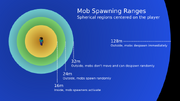
Various mob spawning ranges, illustrated
Monsters, bats, squids, ocelots, and hostile wolves can cease to exist, or "despawn", under certain conditions:
- A mob that has had no player within 32 blocks of it for more than 30 seconds has a 1 in 800 chance of despawning on each game tick (1/20th of a second). Therefore, the half-life of monsters not within 32 blocks of a player is 27.73 seconds (after the initial 30 seconds have elapsed).
- A mob will immediately despawn if there is no player within 128 blocks of it. Note that this is a Euclidean sphere, not a cylinder from map top to bottom and not a taxicab sphere (which is more like an octahedron). Example: A mob at 0/y/0 will remain at least 30 seconds (as above) if the player moves to 65/y/65 (real distance 91.9), but despawns immediately if the player moves to 91/y/91 (real distance 128.7).
- All hostile mobs (including those that are holding items) in a world will despawn if the difficulty is set to peaceful, regardless as to where the player is positioned in the world.
- In multiplayer, despawning does not occur while there are no players in the game.
- A monster which has been named with a name tag will not despawn. However, one created from a renamed spawn egg will despawn as normal.
- If a monster is holding any items or wearing any armor that was given by a player or picked up from the ground, it will not despawn.
- Chickens that originally spawned as chicken jockeys follow zombie despawn rules, rather than chicken despawn rules. In other words, they will despawn.
History
{{Histórico}} em vez disso.{{Histórico}} em vez disso.{{Histórico}} em vez disso.{{Histórico}} em vez disso.{{Histórico}} em vez disso.{{Histórico}} em vez disso.{{Histórico}} em vez disso.{{Histórico}} em vez disso.{{Histórico}} em vez disso.{{Histórico}} em vez disso.{{Histórico}} em vez disso.{{Histórico}} em vez disso.{{Histórico}} em vez disso.{{Histórico}} em vez disso.Issues
Problemas relacionados com "Geração" são mantidos no rastreador de erros. Reporte problemas lá, em inglês.
Trivia
- Sometimes it is possible for the world spawn to be positioned in the ocean.
- It is possible for the spawn point of a world to be in a lava lake, in which case starting a game in Survival is nearly impossible unless there is water nearby.
External links
- Forum thread by Marglyph about the spawning algorithm in Beta 1.2
- Forum thread by fr0stbyte124 on mob spawning in Alpha 1.1.2_01 from before the Halloween Update changes
pt:Geração
